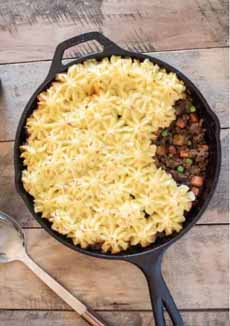RECIPE: Vegetarian Shepherd’s Pie For World Vegetarian Day & Meatless Mondays
|
October 1st is World Vegetarian Day, founded in 1977 by the North American Vegetarian Society. While October 1st is the annual kick-off day, the whole of October is Vegetarian Awareness Month. For a comfort food celebration, we propose a vegetarian version of Shepherd’s Pie (recipe below). Shepherd’s pie, made with minced mutton/lamb—called cottage pie when made with beef—is a dinner dish that originated among agricultural households in the United Kingdom and Ireland. Meat and vegetables—onions, carrots, celery, peas—are enveloped in a sauce like pot pie. But a layer of mashed potatoes serves as the top crust, and turns golden brown in the oven. The mashed potatoes are sometimes topped with grated cheese, which creates a garnish of melted cheese. You can try the shepherd’s pie mashed potato crust with chicken pot pie or other favorite pot pie recipe. Trivia: Pies were originally savory dishes. Here’s the history of pie. Shepherd’s Pie History Meat pies stretched leftover meat scraps by baking them in a pie plate with vegetables. In early cookbooks, shepherd’s pie was a created to use leftover roasted meat of any kind, and both the top and bottom crusts were made from mashed potatoes: The pie pan was lined with mashed potatoes on the bottom and sides as well as the top. The term cottage pie was in use by 1791, as the potato was being introduced as a food crop affordable by the poor (the history of potatoes). “Cottage” referred to the modest dwellings of rural workers. The term shepherd’s pie does not appear until 1854, and was used synonymously with cottage pie. At some point, convention evolved; shepherd’s pie denoted mutton, and cottage pie referred to beef source] In recent times, a vegetarian or vegan version has been called a shepherdess pie. Enjoy it on not only during Vegetarian Awareness Month, but on all the Meatless Mondays that follow. Every culture that makes pastry creates some form pastry with meat. One of our favorites is Chinese barbecued pork buns (char siu bao). Here are some variations that are closer to England: This combination of eggplant, tomatoes and zucchini is creatively topped by a thick layer of polenta instead of mashed potatoes (photo #1). It’s given some kick with the addition of diced jalapeño. Polenta is gluten free, and is whole grain if it is labeled “whole corn” or “whole grain corn.” If the label says “degermed corn,” then the germ layer has been removed. You can used mashed potatoes or mashed sweet potatoes instead of polenta if you prefer. You can also add bell peppers to the vegetable mix. The recipe is adapted from Good Eggs in San Francisco. |
 [1] The featured recipe uses a polenta top instead of the conventional mashed potatoes (photo courtesy Good Eggs)
|
|
|
Ingredients For 6 To 8 Servings 1. PREHEAT the oven to 425°F. 2. ADD some olive oil to a large saucepan over medium-high heat; when hot add and the onion and cook until it is translucent, about 5 minutes. Turn off the heat and add the eggplant and zucchini. Swirl the saucepan, and pour into an 8½ by 11-inch baking dish. 3. ADD the tomatoes, jalapeño, garlic, thyme, 1-2 tablespoons of olive oil to taste. Season with a big pinch of salt and mix together with your hands. Bake for 30 to 35 minutes. While the vegetables cook… 4. MAKE the polenta according to package instructions. When the polenta is done, remove from the heat and add 2 tablespoons of olive oil. Then, either season with salt or add the butter and sprinkle with the parmesan. Set aside for a few minutes. When the vegetables are done… 5. POUR the polenta over the vegetables, using a silicone spatula to spread the the polenta into an even layer. If you wish, top with the gruyère/mozzarella and bake for another 5 minutes until the cheese is melted. Serve immediately so the polenta is at peak consistency. *“Good King Wenceslas looked out on the feast of Stephen”…and likely saw a St. Stephen’s Pie. St. Stephen was the first Christian martyr. His feast day falls on December 26th, and is widely celebrated in Ireland, as well as other countries where St. Stephen’s Day is an official holiday (Croatia, Finland, Germany, Italy, Poland, Ukraine and the Philippines, for example). It happens to coincide with British Boxing Day, the day after Christmas, for which it is also served [source]. The dish is a way to use up leftover Christmas ham and turkey or goose. Since turkey was a latecomer to England (an import from America), earlier versions used goose. |
||





